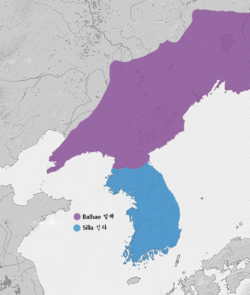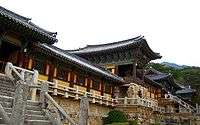North–South States Period
| North–South States Period | |
 | |
| Hangul | 남북국시대 |
|---|---|
| Hanja | 南北國時代 |
| Revised Romanization | Nambukgukshidae |
| McCune–Reischauer | Nampukkuksitae |
Part of a series on the |
||||||||
|---|---|---|---|---|---|---|---|---|
| History of Korea | ||||||||
 | ||||||||
| Prehistory | ||||||||
| Ancient | ||||||||
| Proto–Three Kingdoms | ||||||||
| Three Kingdoms | ||||||||
|
||||||||
| North–South States | ||||||||
|
||||||||
| Later Three Kingdoms | ||||||||
|
||||||||
| Unitary dynastic period | ||||||||
|
||||||||
| Colonial period | ||||||||
|
||||||||
| Division of Korea | ||||||||
|
||||||||
| By topic | ||||||||
| Timeline | ||||||||
|
| ||||||||
North–South States Period (698–926 CE) is the period in Korean history when Later Silla and Balhae coexisted in the south and north of the peninsula, respectively.[1][2]
Later Silla
After the unification wars, the Tang Dynasty established territories in the former Goguryeo, and began to administer and establish communities in Baekje. Silla attacked the Chinese in Baekje and northern Korea in 671.
The Tang Dynasty then invaded Silla in 674 but Silla defeated the Tang army in the north. Silla drove the Tang forces out of the peninsula by 676 to achieve unification of most of the Three Kingdoms.
Later Silla was a golden age of art and culture,[3][4][5][6] and Buddhism became a large part of Silla culture. Buddhist monasteries such as the Bulguksa are examples of advanced Korean architecture and Buddhist influence. State-sponsored art and architecture from this period include Hwangnyongsa Temple, Bunhwangsa Temple, and Seokguram Grotto, a World Heritage Site.
Later Silla carried on the maritime prowess of Baekje, which acted like the Phoenicia of medieval East Asia,[7] and during the 8th and 9th centuries dominated the seas of East Asia and the trade between China, Korea and Japan, most notably during the time of Jang Bogo; in addition, Silla people made overseas communities in China on the Shandong Peninsula and the mouth of the Yangtze River.[8][9][10][11] Later Silla was a prosperous and wealthy country,[12] and its metropolitan capital of Gyeongju[13] was the fourth largest city in the world.[14] [15][16][17]
Buddhism flourished during this time, and many Korean Buddhists gained great fame among Chinese Buddhists[18] and contributed to Chinese Buddhism,[19] including: Woncheuk, Wonhyo, Uisang, Musang,[20][21][22][23] and Kim Gyo-gak, a Silla prince whose influence made Mount Jiuhua one of the Four Sacred Mountains of Chinese Buddhism.[24][25][26][27][28]
Silla began to experience political troubles in the late 9th century. This severely weakened Silla and soon thereafter, descendants of the former Baekje established Later Baekje. In the north, rebels revived Goguryeo, beginning the Later Three Kingdoms period.
Later Silla lasted for 267 years until, under King Gyeongsun, it was annexed by Goryeo in 935.
Balhae
Balhae, the name of which was another transcribed version of Mohe (靺鞨, a Tungus Tribe speaking a language like Manchurian and Sibe), was founded after Goguryeo had fallen. It was founded in the northern part of former lands of Goguryeo by Dae Joyeong, a former Goguryeo general, after defeating the military of central government of Tang Dynasty at the Battle of Tianmenling. Balhae controlled the northern areas of the Korean Peninsula, much of Manchuria, and expanded into present-day Russian Maritime Province. Balhae styled itself as Goguryeo's successor state.
In a time of relative peace and stability in the region, Balhae flourished in culture, especially during the long reign of the third King Mun (r. 737-793) and King Seon. At that time, Balhae was a culturally advanced country, so that even China referred to this kingdom as "a prosperous country of the East." However, Balhae was severely weakened by the 10th century, and the Khitan Liao Dynasty conquered Balhae in 926.
Goryeo absorbed some of Balhae's territory and received Balhae refugees, including the crown prince and the royal family, but compiled no known histories of Balhae. The 18th century Joseon dynasty historian Yu Deukgong advocated the proper study of Balhae as part of Korean history, and coined the term "North and South States Period" to refer to this era.
Language
Due to the lack of linguistic evidence, it is difficult to make a definitive conclusion for the linguistic relation between the Balhae and Silla languages.
Shoku Nihongi implies that the Balhae language, a Goguryeo language, and Silla language share a close relationship: a student sent from Silla to Japan for an interpreter training in Japanese language assisted a diplomatic envoy from Balhae in communicating during the Japanese court audience.
Because of the official and wide use of Chinese written system, there are only two surviving Balhae words: kundufu (transcribed as 可毒夫) meaning "king" and furuki for "stable". They seem to have more Tungusic linguistic relationship and origins than Koreanic.
See also
References
- ↑ Encyclopedia, Naver.
- ↑ Korean Britannica Encyclopedia, Daum.
- ↑ DuBois, Jill. Korea. Marshall Cavendish. p. 22. ISBN 9780761417866. Retrieved 29 July 2016.
- ↑ Randel, Don Michael. The Harvard Dictionary of Music. Harvard University Press. p. 273. ISBN 9780674011632. Retrieved 29 July 2016.
- ↑ Hopfner, Jonathan. Moon Living Abroad in South Korea. Avalon Travel. p. 21. ISBN 9781612386324. Retrieved 29 July 2016.
- ↑ Kim, Djun Kil. The History of Korea. ABC-CLIO. p. 47. ISBN 9780313038532. Retrieved 30 September 2016.
- ↑ Kitagawa, Joseph. The Religious Traditions of Asia: Religion, History, and Culture. Routledge. p. 348. ISBN 9781136875908. Retrieved 21 July 2016.
- ↑ Gernet, Jacques. A History of Chinese Civilization. Cambridge University Press. p. 291. ISBN 9780521497817. Retrieved 21 July 2016.
- ↑ Reischauer, Edwin Oldfather. Ennins Travels in Tang China. John Wiley & Sons Canada, Limited. pp. 276–283. ISBN 9780471070535. Retrieved 21 July 2016. "From what Ennin tells us, it seems that commerce between East China, Korea and Japan was, for the most part, in the hands of men from Silla. Here in the relatively dangerous waters on the eastern fringes of the world, they performed the same functions as did the traders of the placid Mediterranean on the western fringes. This is a historical fact of considerable significance but one which has received virtually no attention in the standard historical compilations of that period or in the modern books based on these sources. . . . While there were limits to the influence of the Koreans along the eastern coast of China, there can be no doubt of their dominance over the waters off these shores. . . . The days of Korean maritime dominance in the Far East actually were numbered, but in Ennin's time the men of Silla were still the masters of the seas in their part of the world."
- ↑ Kim, Djun Kil. The History of Korea, 2nd Edition. ABC-CLIO. p. 3. ISBN 9781610695824. Retrieved 21 July 2016.
- ↑ Seth, Michael J. A Concise History of Korea: From the Neolithic Period Through the Nineteenth Century. Rowman & Littlefield. p. 65. ISBN 9780742540057. Retrieved 21 July 2016.
- ↑ MacGregor, Neil. A History of the World in 100 Objects. Penguin UK. ISBN 9780141966830. Retrieved 30 September 2016.
- ↑ Chŏng, Yang-mo; Smith, Judith G.; Metropolitan Museum of Art (New York, N.Y.). Arts of Korea. Metropolitan Museum of Art. p. 230. ISBN 9780870998508. Retrieved 30 September 2016.
- ↑ International, Rotary. The Rotarian. Rotary International. p. 28. Retrieved 30 September 2016.
- ↑ Ross, Alan. After Pusan. Faber & Faber. ISBN 9780571299355. Retrieved 30 September 2016.
- ↑ Mason, David A. "Gyeongju, Korea's treasure house". Korea.net. Korean Culture and Information Service (KOCIS). Retrieved 30 September 2016.
- ↑ Adams, Edward Ben. Koreaʾs pottery heritage. Seoul International Pub. House. p. 53. Retrieved 30 September 2016.
- ↑ Mun, Chanju; Green, Ronald S. Buddhist Exploration of Peace and Justice. Blue Pine Books. p. 147. ISBN 9780977755301. Retrieved 29 July 2016.
- ↑ McIntire, Suzanne; Burns, William E. Speeches in World History. Infobase Publishing. p. 87. ISBN 9781438126807. Retrieved 29 July 2016.
- ↑ Jr, Robert E. Buswell; Jr, Donald S. Lopez. The Princeton Dictionary of Buddhism. Princeton University Press. p. 187. ISBN 9781400848058. Retrieved 29 July 2016.
- ↑ Poceski, Mario. Ordinary Mind as the Way: The Hongzhou School and the Growth of Chan Buddhism. Oxford University Press. p. 24. ISBN 9780198043201. Retrieved 29 July 2016.
- ↑ Wu, Jiang; Chia, Lucille. Spreading Buddha's Word in East Asia: The Formation and Transformation of the Chinese Buddhist Canon. Columbia University Press. p. 155. ISBN 9780231540193. Retrieved 29 July 2016.
- ↑ Wright, Dale S. The Zen Canon: Understanding the Classic Texts. Oxford University Press. ISBN 9780199882182. Retrieved 29 July 2016.
- ↑ Su-il, Jeong. The Silk Road Encyclopedia. Seoul Selection. ISBN 9781624120763. Retrieved 29 July 2016.
- ↑ Nikaido, Yoshihiro. Asian Folk Religion and Cultural Interaction. Vandenhoeck & Ruprecht. p. 137. ISBN 9783847004851. Retrieved 29 July 2016.
- ↑ Leffman, David; Lewis, Simon; Atiyah, Jeremy. China. Rough Guides. p. 519. ISBN 9781843530190. Retrieved 29 July 2016.
- ↑ Leffman, David. The Rough Guide to China. Penguin. ISBN 9780241010372. Retrieved 29 July 2016.
- ↑ DK Eyewitness Travel Guide: China. Penguin. p. 240. ISBN 9781465455673. Retrieved 29 July 2016.